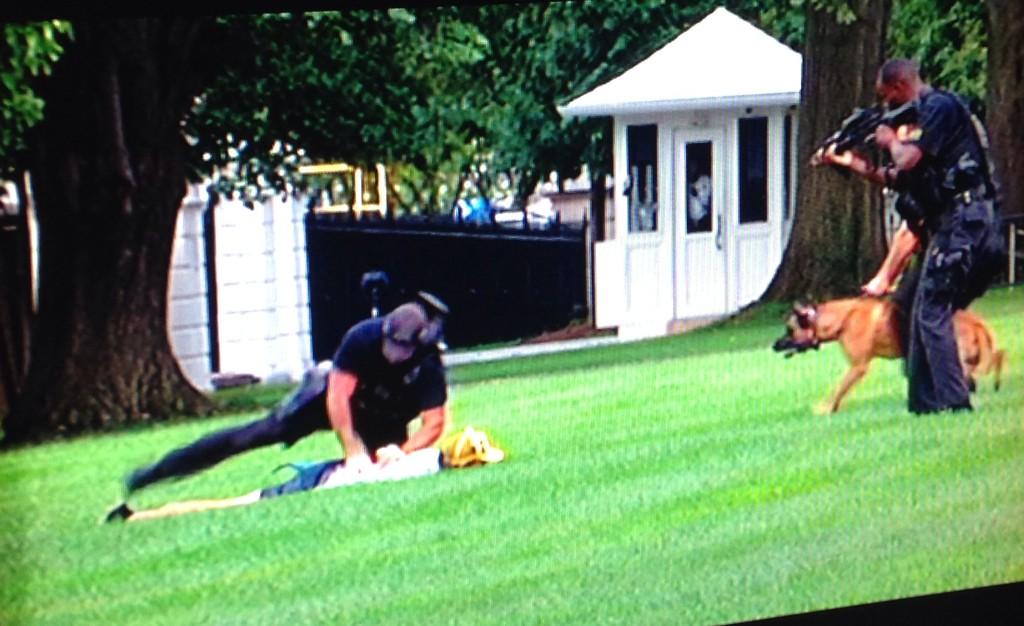 |
| On September 11, 2014 this fellow jumped the White House fence, holding a Pikachu doll and dressed in Pokémon garb. Good thing the Secret Service got the machine guns and killer dogs out. How long until they kill one of these mentally ill people? On October 24, 2014, Dominic Adesanya was bitten multiple times by these dogs; he was unarmed and apparently is a paranoid schizophrenic. For psychiatric reasons, he was found incompetent to stand trial. |
"[In 1835,] Richard Lawrence, an unemployed housepainter who earlier that year had twice visited the White House asking to speak to President Andrew Jackson. On his second visit, he was admitted, met Jackson, and asked him for $1,000. The president said he was busy and Lawrence was sent away. A week later, Lawrence approached Jackson as he was leaving a funeral and fired two pistols at him. Both guns misfired, and the enraged Jackson charged the gunman and began beating him with his cane. Lawrence later told police that the president had killed his father. He also claimed to be King Richard III. At his trial, it took the jury five minutes to find Lawrence not guilty by reason of insanity, and he spent the next 20 years at various asylums before he was eventually transferred to the newly opened Government Hospital for the Insane, now known as St Elizabeth's.
Over the next century and a half, St. Elizabeth’s became a temporary home for thousands of disturbed people who travelled from all over the country to deliver a warning, offer policy advice, or seek redress of grievance with the president, or another high official, in person. To security personnel and psychiatrists alike, they’re known as White House cases. Although they include would-be assassins such as Lawrence and John Hinckley, who shot President Reagan in 1981, the vast majority aren’t armed or violent. In a 1943 study of White House cases, Dr. Jay Hoffman noted, “It is the rule that these patients are, with certain notable exceptions, quiet, pleasant, congenial, cooperative and well-behaved. They accept their enforced hospitalization with a remarkable degree of passivity and frequently without even verbal complaint.”
Typical cases have remained strikingly similar over the years. “People usually go to the White House to tell the president what God is telling them or to warn of some impending disaster,” says psychiatrist David Shore, who worked at St. Elizabeth’s in the 1970s and 80s. “In some cases, they think that they have come up with a great invention or performed some great deed and expect to be rewarded.”
Most are schizophrenic. Some are experiencing a temporary psychotic episode. A few are on drugs. The basic motivation—to accomplish great things or avert great danger by going right to the top—seems to have remained the same throughout the decades, although over the years, specific concerns have shifted. Case studies by a number of researchers provide snapshots both of the historical period in which they occurred, and of the delusions associated with them. Many of Hoffman’s patients came to Washington to complain about pensions owed them from service in the First World War, to advise the president on how to steer the country out of the Depression, or to warn him about Nazi plots. After John F. Kennedy took office, women arrived claiming that they were his wife, and after he was shot, men came announcing that they were Jackie Kennedy’s husband. In a 1965 paper, Dr. Joseph Sebastiani reported that a 44-year-old woman came to the White House in 1963 because “she hoped the president would stop the police persecution that had caused her ears to flop and her body to go out of shape.” After news of President Reagan’s polyp surgery in 1987, one man came to offer him a nutritional cure-all, dressed as Hitler."
No comments:
Post a Comment
Note: Only a member of this blog may post a comment.